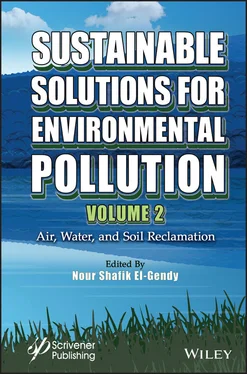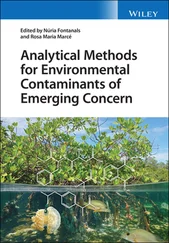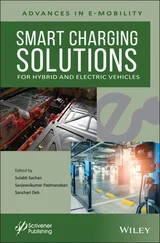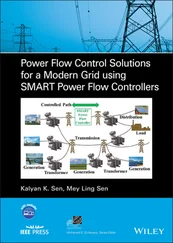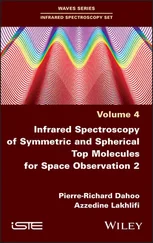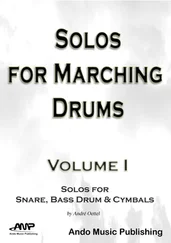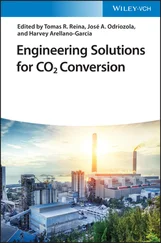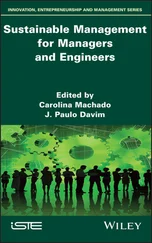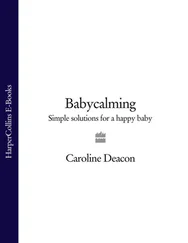Sustainable Solutions for Environmental Pollution, Volume 2
Здесь есть возможность читать онлайн «Sustainable Solutions for Environmental Pollution, Volume 2» — ознакомительный отрывок электронной книги совершенно бесплатно, а после прочтения отрывка купить полную версию. В некоторых случаях можно слушать аудио, скачать через торрент в формате fb2 и присутствует краткое содержание. Жанр: unrecognised, на английском языке. Описание произведения, (предисловие) а так же отзывы посетителей доступны на портале библиотеки ЛибКат.
- Название:Sustainable Solutions for Environmental Pollution, Volume 2
- Автор:
- Жанр:
- Год:неизвестен
- ISBN:нет данных
- Рейтинг книги:3 / 5. Голосов: 1
-
Избранное:Добавить в избранное
- Отзывы:
-
Ваша оценка:
- 60
- 1
- 2
- 3
- 4
- 5
Sustainable Solutions for Environmental Pollution, Volume 2: краткое содержание, описание и аннотация
Предлагаем к чтению аннотацию, описание, краткое содержание или предисловие (зависит от того, что написал сам автор книги «Sustainable Solutions for Environmental Pollution, Volume 2»). Если вы не нашли необходимую информацию о книге — напишите в комментариях, мы постараемся отыскать её.
This second volume in a broad, comprehensive two-volume set, “Sustainable Solutions for Environmental Pollution”, concentrates on air, water, and soil reclamation, some of the biggest challenges facing environmental engineers and scientists today.
AUDIENCE: Sustainable Solutions for Environmental Pollution,
Sustainable Solutions for Environmental Pollution, Volume 2 — читать онлайн ознакомительный отрывок
Ниже представлен текст книги, разбитый по страницам. Система сохранения места последней прочитанной страницы, позволяет с удобством читать онлайн бесплатно книгу «Sustainable Solutions for Environmental Pollution, Volume 2», без необходимости каждый раз заново искать на чём Вы остановились. Поставьте закладку, и сможете в любой момент перейти на страницу, на которой закончили чтение.
Интервал:
Закладка:
Figure 1.2 The OTHU self-purification device based on a porous wood weir.
A pilot site was setup in 2000, as part of OTHU’s long-term outdoor observatory project ( http://www.graie.org/othu/), to assess the impact of a self-purification device for combined sewer overflow discharges on a seasonal urban watercourse, with the aim of understanding the articulation between geomorphic, hydrological, and biotic components and identifying levers to modulate the impact of the pollutant discharge ( Figure 1.2). Urban development increases the frequency of small floods (Braud et al. , 2013) and riverbed erosion (Navratil et al. , 2013), leading to biodiversity losses due to both poor water quality and poor geomorphic diversity.
Constructed porous ramps (groynes) aim at the induction of oxic/ anoxic sequences conducive to biodegradation. Optimization key points have been identified:
1 Trapping capacity of the porous groynes. It depends on the particle size distribution of the pollution (70% to 90% of the pollution in combined sewer overflows (CSOs)), the Stockes law, the downstream hydraulic gradient, and the dissipation of turbulence energy at the water-sediment interface. The trapping capacity will condition the length of the porous sediment and the height of the groyne;
2 Minimum residence time to allow biodegradation during the circulation of the hyporheic flux and oxygen consumption (oxic to anoxic conditions). The required residence time depends on the considered biodegradation kinetics considered. The volume and shape of the porous sediment influence the upwelling and down-welling flows which can be used to control and adjust the residence time;
3 Efficient operating system design at low flow rates. It functions as a hydraulic control point to maintain a critical water depth (by maximizing the down-welling flow of pollutants and dissolved oxygen); and when submerged at high flow rates, it does not increase the height of water during floods;
4 Frequency of self-regeneration of porous sediments over several decimetres. It depends mainly on the granulometry and inclination of the surface of the porous sediments. Computational Fluid Dynamics (CFD) tools help us in this task before developing a model of the compartmental type that is easy to be used by engineering offices.
As part of the ANR-EPEC research project, a series of physical-chemical parameters were monitored weekly for one year, both in surface waters and hyporheic waters of porous sediments accumulated behind three artificial porous weirs, built just downstream of a CSO outfall. The total length of the porous sediments was 60 m. Weekly analyses of the samples showed very effective trapping of organic pollution from the porous systems, especially during periods of low flow with fluctuating concentrations of C, N, and P compounds above their tolerance limits 20% of the time, while the downstream water quality was always below the pollution limits. These fluctuations illustrate the succession over time of the trapping and biodegradation processes. In the hyporheic zone, the nitrification and then denitrification processes along the hyporheic flow (Aucour et al. , 2013) were demonstrated and confirmed by microbial analyses. The residence time was calculated from the phase shift of the daily variations between the surface water temperature and the hyporheic water temperature, which led to values ranging from several hours in high flow rate to several days in a low flow rate. Nitrogen and methane gas production was measured at a rate of 1 L/(d.m 2) of porous sediment (Gervaix et al. , 2018). Oxidative and anoxic biodegradation processes were observed depending on the flow rate and the season (Breil et al. , 2007a) and on more or less dissolved oxygen inputs. This, together with temperature, modulates microbial activity and oxygen content. A model of the geometrical shapes effective on water aeration has been developed and has allowed to optimize the parameters (Khdhiri et al. , 2014). The regeneration of porous sediments accumulated behind porous weirs, functioning as artificial bio-filters, has been observed during intense flow events, leading to an increase of dissolved oxygen infiltration in the deep hyporheic layers, and inducing scouring and renewal of the surface layers.
1.5 Bank Filtration for Water Treatment
Bank filtration (BF) process occurs when the hydraulic head in surface water is higher than in underlying groundwater ( Figure 1.3).
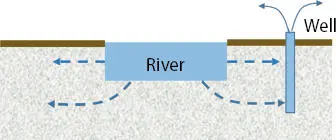
Figure 1.3 The basic principle of bank filtration.
During the BF, the four types of filters act together and their interactions are very strong to remove particles, biodegradable organic compounds, trace organics, microorganisms, as well as ammonia and nitrates. It is a reliable, natural, and multi-objective treatment process applied to rivers or lakes (Gillefalk et al. , 2018). BF has the potential to replace or support other treatment process by providing a robust barrier within a multi-barrier system and also reducing the costs of water treatment in general (Sharma and Amy, 2009). It is known that BF is an efficient and well accepted treatment method of surface water in Europe. For more than 100 years, riverbank filtration has been used as a treatment method in European countries for public and industrial water supply along Rhine, Elbe, and Danube rivers (Grischek et al. , 2003). There exist several mechanisms for improvement of water quality during BF. During infiltration, the surface water moves through the soil and aquifer sediments. During the latter process, surface water is subjected to a combination of physical, chemical, and biological processes such as 1) filtration, 2) solution-precipitation, 3) ion-exchange, 4) sorption-desorption, 5) complexation, 6) redox reactions, 7) microbial biodegradation, and 8) dilution that significantly improve water quality. The main advantages and limitations of BF systems are listed below (Ray et al. , 2002; Gale, 2005).
Advantages:
– BF is a natural treatment process, which avoids or reduces the use of chemicals and produces biologically stable water as end-product;
– BF improves water quality by removing particles (suspended solids), organic pollutants, microorganisms, metals, and nitrogen from the surface water;
– BF dampens concentration peaks associated with spills (in river/lake) as well as dampens temperature peaks;
– BF replaces or supports other surface water treatment processes by providing a robust barrier and reduces the overall cost of surface water treatment.
Limitations:
– BF is site specific (rivers or lakes) and is feasible only when the local hydrogeological conditions are favorable and known;
– Leaching of the aquifer materials can occur under reducing conditions, sometimes leading to increased concentration of iron and manganese in extracted water;
– Another problem is clogging of the aquifer due to accumulation of suspended matter that is filtered out when river/lake water enters the aquifer;
– BF and groundwater recharge may be only a limited barrier for certain contaminants that pass through the system;
– Influence of surface water and operation on quality is poorly known.
1.6 Constructed Wetlands (CWs)
In terms of wastewater treatment, natural self-purification processes involving vegetation, sediments and their associated biocenosis and microbiocenosis (phytobiome) are applied in CWs (Vymazal, 2007). These latter, together with iron oxidation bioreactors and composting reactors belong to the so-called passive biological treatments. The advanced technologies include acid mine drainage (AMD) treatment in bioreactors with sulfate-reducing bacteria cocktails (Neculita et al. , 2007) and CWs (Johnson and Hallberg, 2005). The cost factor involved in the passive treatment of water may be a large start-up cost but is ideal in the natural rehabilitation of water over time.
Читать дальшеИнтервал:
Закладка:
Похожие книги на «Sustainable Solutions for Environmental Pollution, Volume 2»
Представляем Вашему вниманию похожие книги на «Sustainable Solutions for Environmental Pollution, Volume 2» списком для выбора. Мы отобрали схожую по названию и смыслу литературу в надежде предоставить читателям больше вариантов отыскать новые, интересные, ещё непрочитанные произведения.
Обсуждение, отзывы о книге «Sustainable Solutions for Environmental Pollution, Volume 2» и просто собственные мнения читателей. Оставьте ваши комментарии, напишите, что Вы думаете о произведении, его смысле или главных героях. Укажите что конкретно понравилось, а что нет, и почему Вы так считаете.
